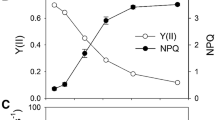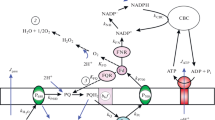Abstract
Oscillations in the rate of photosynthesis of sunflower (Helianthus annuus L.) leaves were induced by subjecting leaves, whose photosynthetic apparatus had been activated, to a sudden transition from darkness or low light to high-intensity illumination, or by transfering them in the light from air to an atmosphere containing saturating CO2. It was found that at the first maximum, light-and CO2-saturated photosynthesis can be much faster than steady-state photosynthesis. Both QA in the reaction center of PS II and P700 in the reaction center of PS I of the chloroplast electron-transport chain were more oxidized during the maxima of photosynthesis than during the minima. Maxima of P700 oxidation slightly preceded maxima in photosynthesis. During a transition from low to high irradiance, the assimilatory force FA, which was calculated from ratios of dihydroxyacetone phosphate to phosphoglycerate under the assumption that the reactions catalyzed by NADP-dependent glyceraldehydephosphate dehydrogenase, phosphoglycerate kinase and triosephosphate isomerase are close to equilibrium, oscillated in parallel with photosynthesis. However, only one of its components, the calculated phosphorylation potential (ATP)/(ADP)(Pi), paralleled photosynthesis, whereas calculated NADPH/NADP ratios exhibited antiparallel behaviour. When photosynthetic oscillations were initiated by a transition from low to high CO2, the assimilatory force FA declined, was very low at the first minimum of photosynthesis and increased as photosynthesis rose to its second maximum. The observations indicate that the minima in photosynthesis are caused by lack of ATP. This leads to overreduction of the electron-transport chain which is indicated by the reduction of P700. During photosynthetic oscillations the chloroplast thylakoid system is unable to adjust the supply of ATP and NADPH rapidly to demand at the stoichiometric relationship required by the carbonreduction cycle.
Similar content being viewed by others
Abbreviations
- PGA:
-
3-phosphoglycerate
- DHAP:
-
dihydroxyacetone phosphate
- P700 :
-
electron-donor pigment in the reaction enter of PS I
- QA :
-
quinone acceptor in the reaction center of PS II
References
Arnon, D.I., Chain, R.K. (1975) Regulation of ferredoxin-catalyzed photosynthetic phosphorylations. Proc. Natl. Acad. Sci. USA 72, 4961–4965
Arnon, D.I., Chain, R.K. (1979) Regulatory electron transport pathways in cyclic photophosphorylation. FEBS Lett. 102, 133–138
Bradbury, M., Baker, N.R. (1981) Analysis of the slow phases of the chlorophyll fluorescence induction curve. Changes in the redox state of Photosystem II electron acceptors and fluorescence emission from photosystem I and II. Biophys. Acta 635, 542–551
Dietz, K.-J., Heber, U. (1984) Rate-limiting factors in leaf photosynthesis. I. Carbon fluxes in the Calvin cycle. Biochim. Biophys. Acta 767, 432–443
Dietz, K.-J., Heber, U. (1989) Assimilatory force and regulation of photosynthetic carbon reduction in leaves. In: Techniques and new developments in photosynthesis research, vol. 163, pp. 341–363, Barber, J., Malkin, R., eds. NATO ASJ Series A, Plenum Press, New York
Furbank, C.H., Foyer, F.T. (1986) Oscillations in levels of metabolites from the photosynthetic carbon reduction cycle in spinach leaf disks generated by the transition from air to 5% CO2. Arch. Biochem. Biophys. 245, 240–244
Harris, G.C., Cheesbrough, J.K., Walker, D.A. (1983) Effects of mannose on photosynthetic gas exchange in spinach leaf discs. Plant Physiol. 77, 108–111
Heber, U., Santarius, K.A. (1965) Compartmentation and reduction of pyridine nucleotides in relation to photosynthesis. Biochim. Biophys. Acta 100, 390–408
Heber, U., Santarius, K.A. (1970) Direct and indirect transport of ATP and ADP across the chloroplast envelop. Z. Naturforsch. 25 b, 718–728
Heber, U., Neimanis, S., Viil, J., Dietz, K.-J. (1986) Assimilatory power as a driving force in photosynthesis. Biochim. Biophys. Acta 852, 144–155
Heineke, D., Stitt, M., Heldt, H. (1989) Effects of inorganic phosphate on the light dependent thylakoid energization of intact spinach chloroplasts. Plant Physiol. 91, 221–226
Kurkidjian, A., Guern, J. (1989) Intracellular pH: Measurement and importance in cell activity. Annu. Rev. Plant Physiol. 40, 271–303
Laisk, A., Walker, D.A. (1986) Control of phosphate turnover as a rate-limiting factor and possible source of oscillations in photosynthesis, a mathematical model. Proc. R. Soc. London B 227 281–302
Laisk, A., Eichelmann, H. (1989) Towards understanding oscillations: a mathematical model of the biochemistry of photosynthesis. In: New vistas in measurement of photosynthesis pp 143–157, Walker, D.A. Osmond, C.B., eds. The Royal Society, London
Lechtenberg, D., Voss, B., Weis, E. (1990) Regulation of photosynthesis: Photosynthetic control and thioredoxin-dependent enzyme regulation. In: Current research in photosynthesis, vol. 4, pp. 171–174, Baltscheffsky, M., ed. Kluwer Academic Publishers, Dordrecht
Michal, G. (1984) d-fructose 1,6-bisphosphate, dihydroxyacetone phospate and d-glyceraldehyde 3-phosphate. In: Methods of enzymatic analysis, vol. 6, pp.342–350, Bergmeyer, H.U., ed. Verlag Chemie, Weinheim, FRG
Moss, D.A., Bendall, D.S. (1984) Cyclic electron transport in chloroplasts, the Q-cycle and the site of action of antimycin. Biochim. Biophys. Acta 767, 389–395
Oja, V. (1983) A quick-operating gas measuring device for studying the kinetics of leaf photosynthesis. Fiziol. Rastenii (Sov. Plant Physiol) 30, 1045–52
Oja, V., Laisk, A., Heber, U. (1986) Light-induced alkalization of chloroplast stroma in vivo as estimated from the CO2 capacity of intact sunflower leaves. Biochim. Biophys. Acta 849, 355–365
Ogawa, T. (1982) Simple oscillations in photosynthesis of higher plants. Biochim. Biophys. Acta 681, 103–109
Pfanz, H., Heber, U. (1986) Buffer capcities of leaves, leaf cells and leaf cell organelles in relation to fluxes of potentially acidic gases. Plant Physiol 81, 597–602
Racker, E. (1984) spl-glyceraldehyde 3-phosphate. In: Methods of enzymic analysis, vol. 4, pp. 561–565, Bergmeyer, H.U., Bergmeyer, J., Graßl, M., eds. Verlag Chemie, Weinheim, FRG
Santarius, K.A., Heber, U. (1965) Changes in the intracellular levels of ATP, ADP, AMP and Pi and regulatory function of the adenylate system in leaf cells during photosynthesis. Biochim. Biophys. Acta 100, 39–54
Scheibe, R., Stitt, M. (1988) Comparison of NADP-malate dehydrogenase activation, QA reduction and O2 evolution in spinach leaves. Plant Physiol. Biochem. 26 (4), 473–481
Schreiber, U., Neubauer, C. (1990) O2-dependent electron flow, membrane energization and the mechanism of non-photochemical quenching of chlorophyll fluorescence. Photosynth. Res. 25, 279–293
Schreiber, U., Bilger, W., Schliwa, U. (1986) Continuous recording of photochemical and non-photochemical chlorophyll fluorescence quenching with a new type of modulation fluorometer. Photosynth. Res. 10, 51–62
Schreiber, U., Klughammer, C., Neubauer, C. (1988) Measuring P700 absorbance changes around 830 nm with a new type of pulse modulation system. Z. Naturforsch. 43c, 686–698
Siebke, K., Laisk, A., Oja, V., Kiirats, O., Raschke, K., Heber, U. (1990) Control of photosynthesis in leaves as revealed by rapid gas exchange and measurements of the assimilatory force FA. Planta 182, 513–522
Sivak, M.N., Walker, D.A. (1987) Oscillations and other symptoms of limitation of photosynthesis by inadequate phosphate supply to the chloroplast. Plant Physiol. Biochem. 25 (5), 635–648
Sivak, M.N., Dietz, K.-J., Heber, U., Walker, D.A. (1985) The relationship between light scattering and chlorophyll a fluorescence during oscillations in photosynthetic carbon assimilation. Arch. Biochem. Biophys. 237, 513–519
Stitt, M., (1986) Limitation of photosynthesis by carbon metabolism. 1. Evidence for excess electron transport capacity in leaves carrying out photosynthesis in saturating light and CO2. Plant Physiol. 81, 1115–1122
Stitt, M., Grosse, H., Woo, K.-C. (1988) Interactons between sucrose synthesis and CO2` `fixation. II. Alterations of fructose 2,6-bisphosphate during photosynthetic oscillations. J. Plant Physiol. 133, 133–143
Takahama, U., Shimizu-Takahama, M., Heber, U. (1981) The redox state of the NADP system in illuminated chloroplasts. Biochim. Biophys. Acta 637, 530–539
Usuda, H. (1988) Adenine nucleotide levels, the redox state of the NADP system, and assimilatory force in nonaqueously purified mesophyll chloroplasts from maize leaves under different light intensities. Plant Physiol. 88, 1461–1468
Wagner, U., Kolbowski, J., Oja, V., Laisk, A., Heber, U. (1990) pH homeostasis of the chloroplast stroma can protect photosynthesis of leaves during the influx of potentially acidic gases. Biochim. Biophys. Acta 1016, 115–120
Weis, E., Lechtenberg, D., Krieger, A. (1990) Physiological control of primary energy conversion in higher plants. In: Current research in photosynthesis, vol. 4, pp. 307–312, Baltscheffsky, M., ed. Kluwer Academic Publishers, Dordrecht, The Netherlands
Walker, D.A., Osmond, C.B. (1986) Measurement of photosynthesis in vivo with a leaf disk electrode; correlations between light dependence of steady state photosynthetic O2 evolution and chlorophyll a fluorescence transients. Proc. R. Soc. London B 227, 281–302
Walker, D.A., Sivak, M.N., Prinsley, R.T., Cheesbrough, J.K. (1983) Simultaneous measurement of oscillations in oxygen evolution and chlorophyll a fluorescence in leaf pieces. Plant Physiol. 73, 542–549
Walker, D.A., Plant, N., Sivak, M.N. (1988) The oxidation status of P700 during oscillations in photosynthetic carbon assimilation, pp. 22–24, Annual Report, Research Institute of Photosynthesis, University of Sheffield
Wulff, K., Döppen, W., (1985) ATP: Luminometric method. In: Methods of enzymatic analysis, vol. 7, pp.357–364, Bergmeyer, H.U., Bergmeyer, J., Graßl, M., eds. Verlag Chemie, Weinheim, FRG
Yin, Z.-H., Neimanis, S., Heber, U. (1990) Light-dependent pH changes in leaves of C3 plants. I. Recording pH changes in various cellular compartments by fluorescent probes. Planta 182, 244–252
Yokota, A., Kitaoka, S. (1985) Correct pK values for dissociation constant of carbonic acid lower the reported Km values of ribulose bisphosphate carboxylase to half. Presentation of a homograph and an equation for determinig the pK values. Biochem. Biophys. Res. Comm. 131, 1075–1079
Author information
Authors and Affiliations
Additional information
This work received support from the Estonian Academy of Sciences, the Bavarian Ministry of Science and Art and the Sonderforschungsbereich 251 of the University of Würzburg. We are grateful for criticism by D.A. Walker, Robert Hill Institute, University of Sheffield, U.K. and by Mark Stitt, Institute of Botany, University of Heidelberg, FRG.
Rights and permissions
About this article
Cite this article
Laisk, A., Siebke, K., Gerst, U. et al. Oscillations in photosynthesis are initiated and supported by imbalances in the supply of ATP and NADPH to the Calvin cycle. Planta 185, 554–562 (1991). https://doi.org/10.1007/BF00202966
Received:
Accepted:
Issue Date:
DOI: https://doi.org/10.1007/BF00202966




